Huawei Mate 20 Review
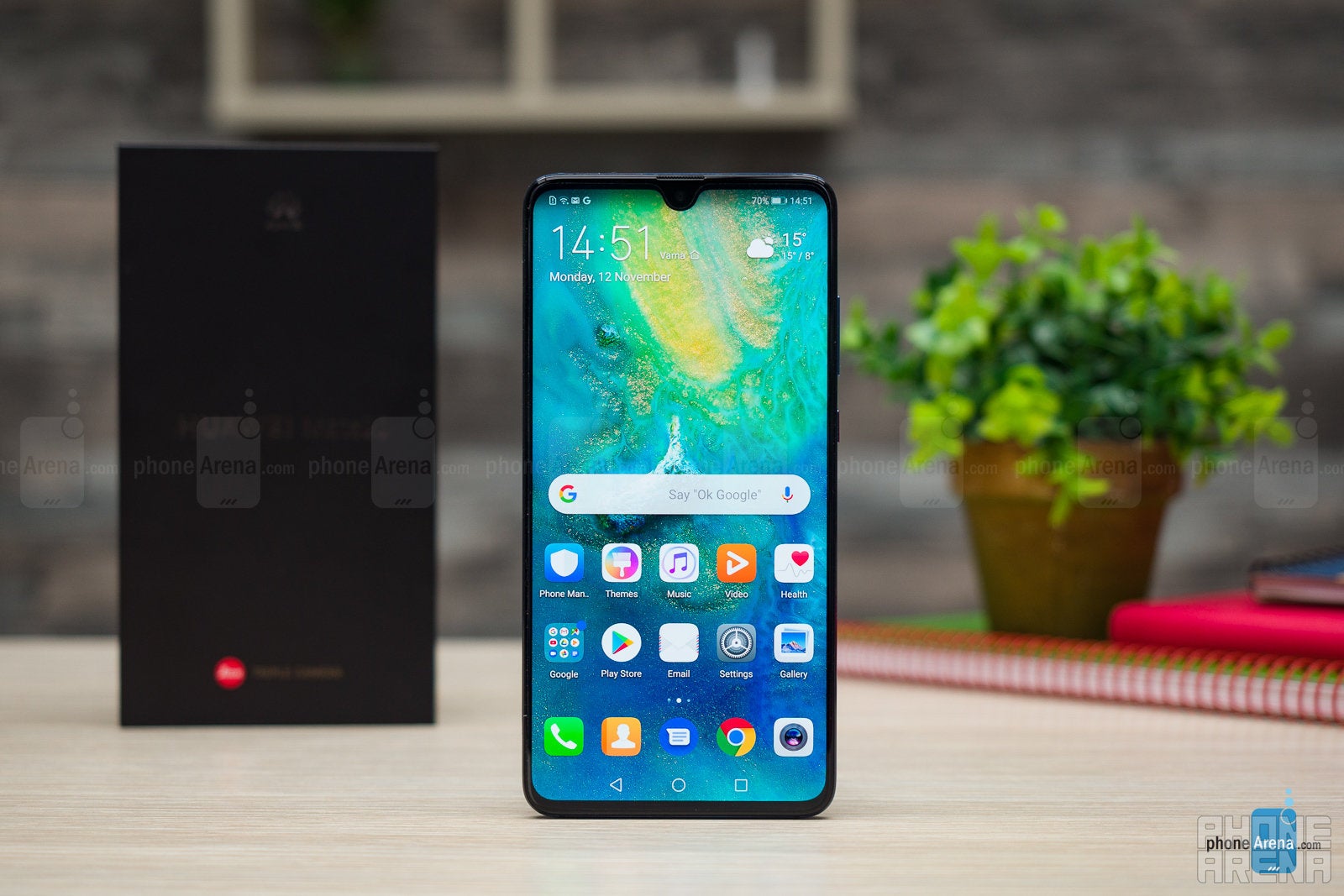
Review index
Huawei’s Mate 20 Pro has captured plenty of attention since its launch and for a good reason: it’s an all-out phone packed with the latest technology, including Android’s most powerful chip, a 3D face recognition system and an exciting triple camera setup.
But what if you just can’t quite afford the Mate 20 Pro, a device priced at the highest end of the market? Huawei has something else for you that still has the same powerful processor and provides mostly the same experience with just a few compromises: enter the Huawei Mate 20.
The Mate 20 is actually a slightly bigger phone than the Pro. It features an edge-to-edge design with a tiny teardrop notch and the Kirin 980, the same chip as on the Pro; it skips on the AMOLED screen and instead uses an LCD display; it lacks the 3D face recognition and the in-screen fingerprint scanner; and it does not have the super fast 40-watt charging from the Pro.
So does it still deserve the Mate 20 name and is it a phone worth buying? Read on to find out, but first, here is...
What’s in the box:
- Huawei Mate 20 phone
- Huawei SuperCharge wall charger (up to 22.5 watts)
- USB-C to standard USB cable
- Headphones with in-line mic (3.5mm jack)
- Translucent silicone case
- SIM ejector tool
- User manual
Design
Bigger than the Mate 20 Pro, but still with a premium feel
Unlike the surprisingly easy to handle Mate 20 Pro, the regular Huawei Mate 20 is actually quite the big and bulky phone, on par with most other XL-sized flagship phones like the iPhone XS Max and Google Pixel 3 XL. This is mostly due to it being much wider, which makes the phone harder to operate with a single hand, but you also gain a bigger screen in exchange for that inconvenience.
Huawei offers a few different colors for the Mate 20: we have the new “midnight blue hyper optical” version, which has a back made of glass with a really peculiar, finely textured finish that sounds just like an old vinyl disc when you scratch it. This new finish is actually quite practical too: it is not such a fingerprint magnet as most other glass phones and is not as slippery in the hand. You also have Huawei’s signature midnight gradient color version and a pure black model.
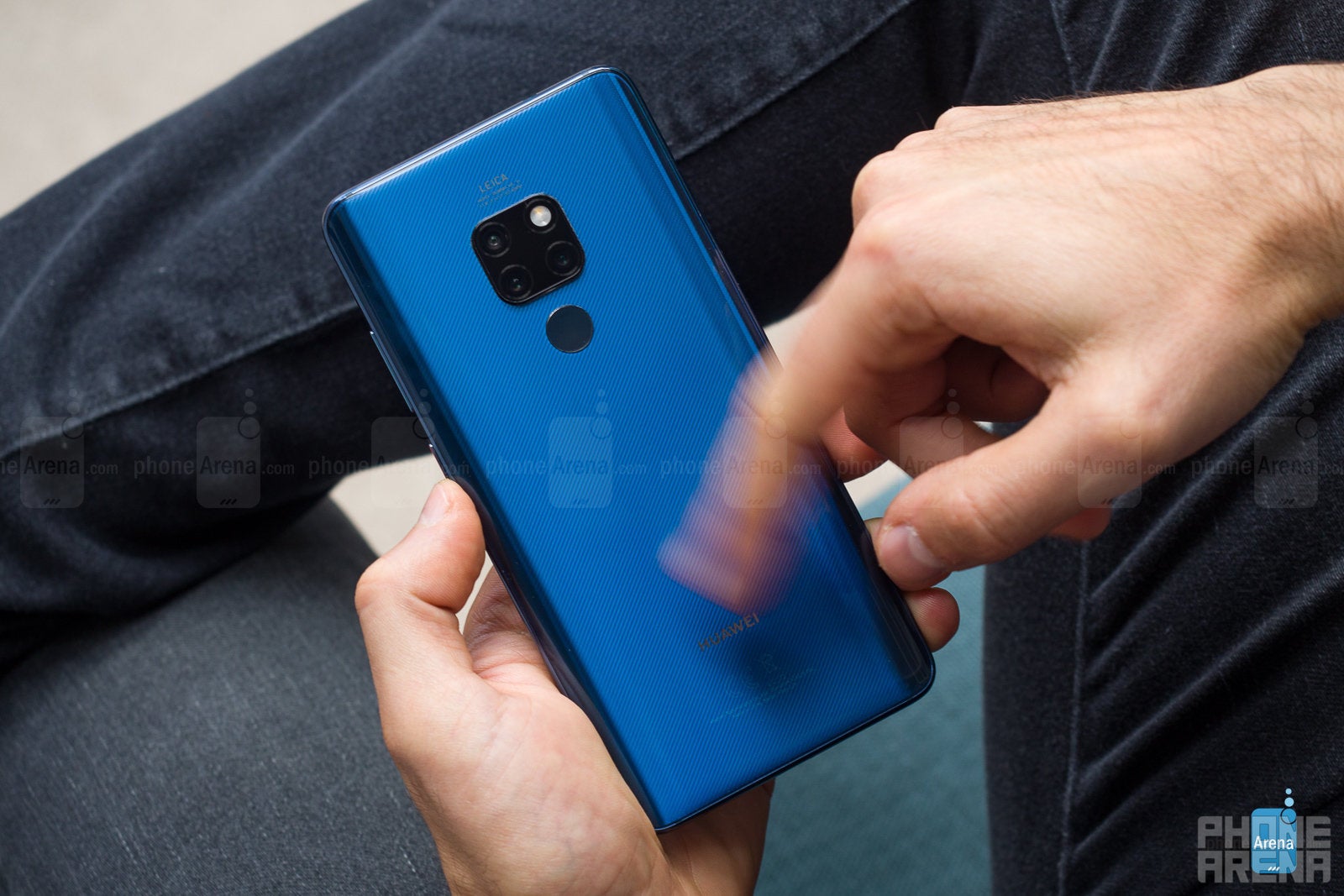
Unlike the Mate 20 Pro, which features a futuristic in-screen fingerprint scanner, you have a traditional fingerprint reader on the Mate 20. It’s located on the back of the phone and is lightning-fast: a quick tap on the finger scanner and you are instantly transported to the phone’s home screen.
All physical buttons on the Mate 20 are on the right side of the phone: you have a power key and volume buttons right above it. The buttons are made of metal, just like the side of the phone, and feel clicky, with a good amount of travel.
Up at the top, you can find an infrared (IR) blaster, which allows you to use your Mate as a remote control unit. The IR blaster works in conjunction with the Smart Remote application that’s pre-loaded on the phone.
Unlike with the Mate 20 Pro, you do have a 3.5mm headphone jack here (it’s located on the top of the phone), so you can easily plug in your good old wired headphones without the need for a clunky dongle. On the bottom, you’d find a USB-C port and a loudspeaker.
One more thing: this phone is IP68 water protected, which translates into an ability to survive drops in water of up to 6 feet deep for as long as 30 minutes.
Display
Most high-end phones these days come with AMOLED screens, but the Mate 20 is a bit of an exception here: it sports a big, 6.5-inch LCD display with an FHD+ (1080 x 2244 pixel) resolution.
There are two notable things here: first, the aspect ratio of the display which is 18.7:9, a noticeably wider screen than the 19.5:9 display on the Pro. Having a wider screen also means having a much bigger actual area, so you have more plentiful space for all of your photos, videos, and browsing needs.
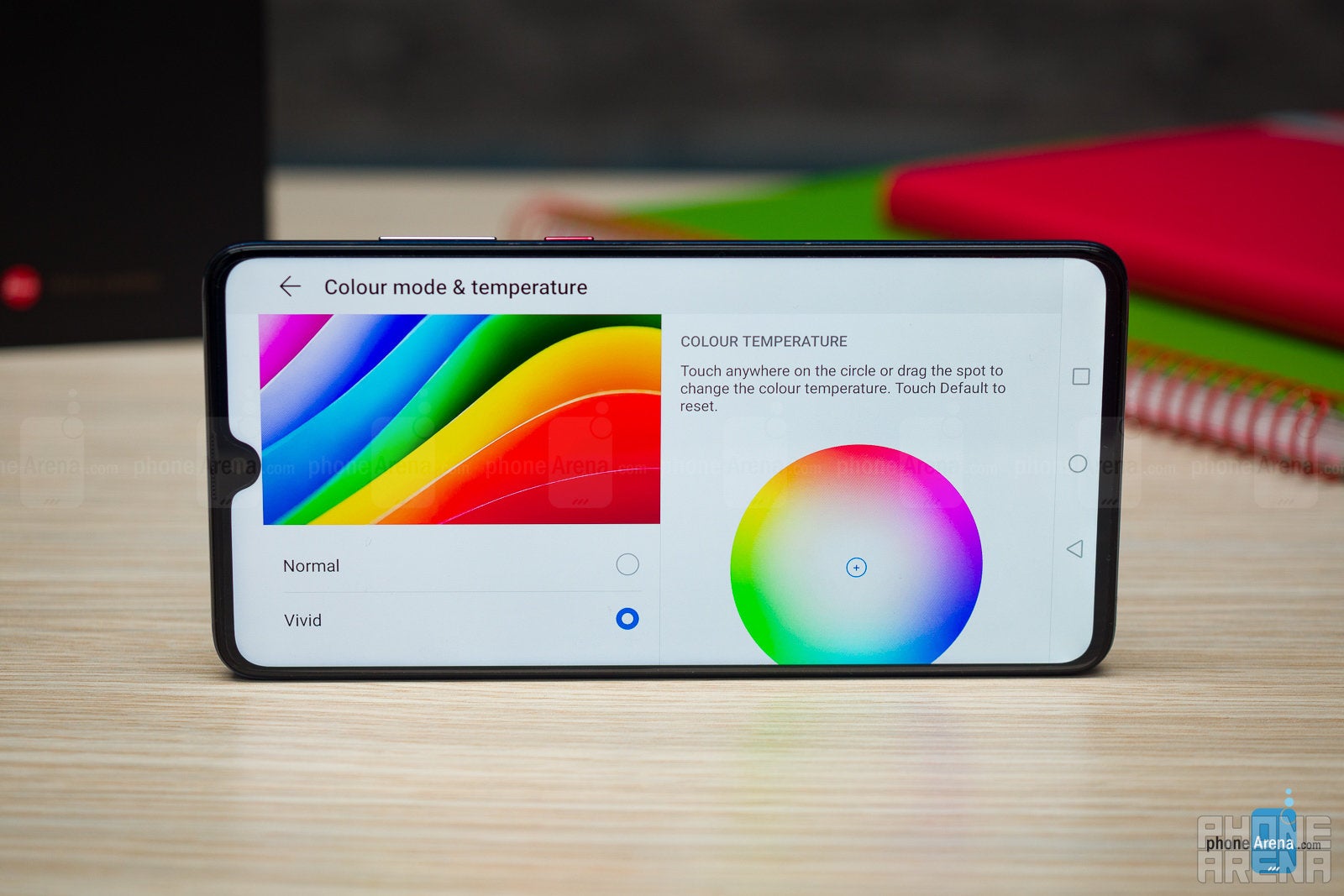
The second thing is the notch, of course. You could hide it via an option in display settings, but it’s really so delicate and tiny that this is not a step that is necessary. The Mate 20 skips on the complex 3D face recognition system from the Pro that requires a lot of front camera components, and this is what makes the tiny notch possible. With it, the regular Mate 20 achieves an incredible screen-to-body ratio of 88.1%, even higher than the already impressive 86.9% ratio on the Pro. The Mate 20 really feels like you are holding one giant screen with almost no bezels in your hands.
The screen here is of the RGBW kind, meaning that has an additional white sub-pixel along with the usual red, white, and green ones. This allows it to get plenty bright during the day. It also improves efficiency, as the screen needs to light up only one sub-pixel instead of three to produce white.
Additionally, you have an Eye Comfort option (a blue light filter, in other words) for use at night and there is even a Natural Tone mode that automatically adjusts the white balance to the surrounding conditions so you get more natural white color hues.
Interface
EMUI is improving, but still a lot left to be desired
The Mate 20 ships with Huawei’s own custom interface, known as Emotion UI (or EMUI), in its most refined, 9.0 version on top of the latest Android 9 Pie.
EMUI is in many ways “influenced” by iOS: from the looks of icons like the Dialer, Health, Settings, Calendar, and Weather, to the gestures, the swipe-down for quick search shortcut and more. It really boggles the mind why companies the scale and size of Huawei still blindly imitate Apple in such a blatant manner, but it is what it is, and functionally, EMUI actually works fairly smoothly. Also, compared to earlier versions of EMUI, there is now way less clutter, and Huawei has repositioned essential in-app buttons to the bottom of the screen for easier reach.
There is also no going around the fact that the Mate 20 may not be the fastest to get Android software updates in the future (if those updates even arrive).
The Mate 20 also features Huawei’s new gesture navigation. The classic three-button Android nav is still the default option, but you can switch to using gestures, and we can confirm that these work well. The gestures are the following: swipe up from the bottom to go home, swipe up and pause to see multitasking cards, and swipe sideways from either edge of the screen to go back. This is basically the iOS way of doing gestures, and it feels more logical than the slightly weird native Android gestures on Google’s Pixel phones. But there is a bit more stutter and the recents shortcut does not quite work as effortlessly as we’d like.
One thing that we like having on the Mate 20 is the dark mode in the interface that you enable by going into Settings > Battery > and here you toggle the “Darken interface colors” option on. It’s definitely easier on the eyes at night.
Processor, Performance and Memory
Android’s fastest chip
While the Mate 20 makes quite a few compromises when compared to the premium Mate 20 Pro model, we’re happy to see that it does not make a compromise in terms of performance. The Mate 20 is powered by the same Huawei Kirin 980 chip. This is Android’s first 7nm chip, which put in simple words means that Huawei is able to cram more transistors into a tinier space, hence better performance without a power consumption increase.
Compared to the ubiquitous Snapdragon 845 chip that you can find on pretty much any Android flagship in 2018, the Kirin is faster, especially if you enable the Performance mode in settings. It’s still no match for Apple’s A12 Bionic chip, though, which was the first 7nm chip to hit the market.
Take a look at the benchmark results below to see how the phone performs:
You also have a spacious 128GB of on-board storage with support for a brand new type of memory card that Huawei calls nanoSD that is the same size as a nano SIM card. Unfortunately, this new standard of memory cards is currently only offered by Huawei and may or may not be adopted by others in the future. In practical terms, you can use the Mate 20 as a dual SIM phone, or use one nanoSD + one nanoSIM.
Camera
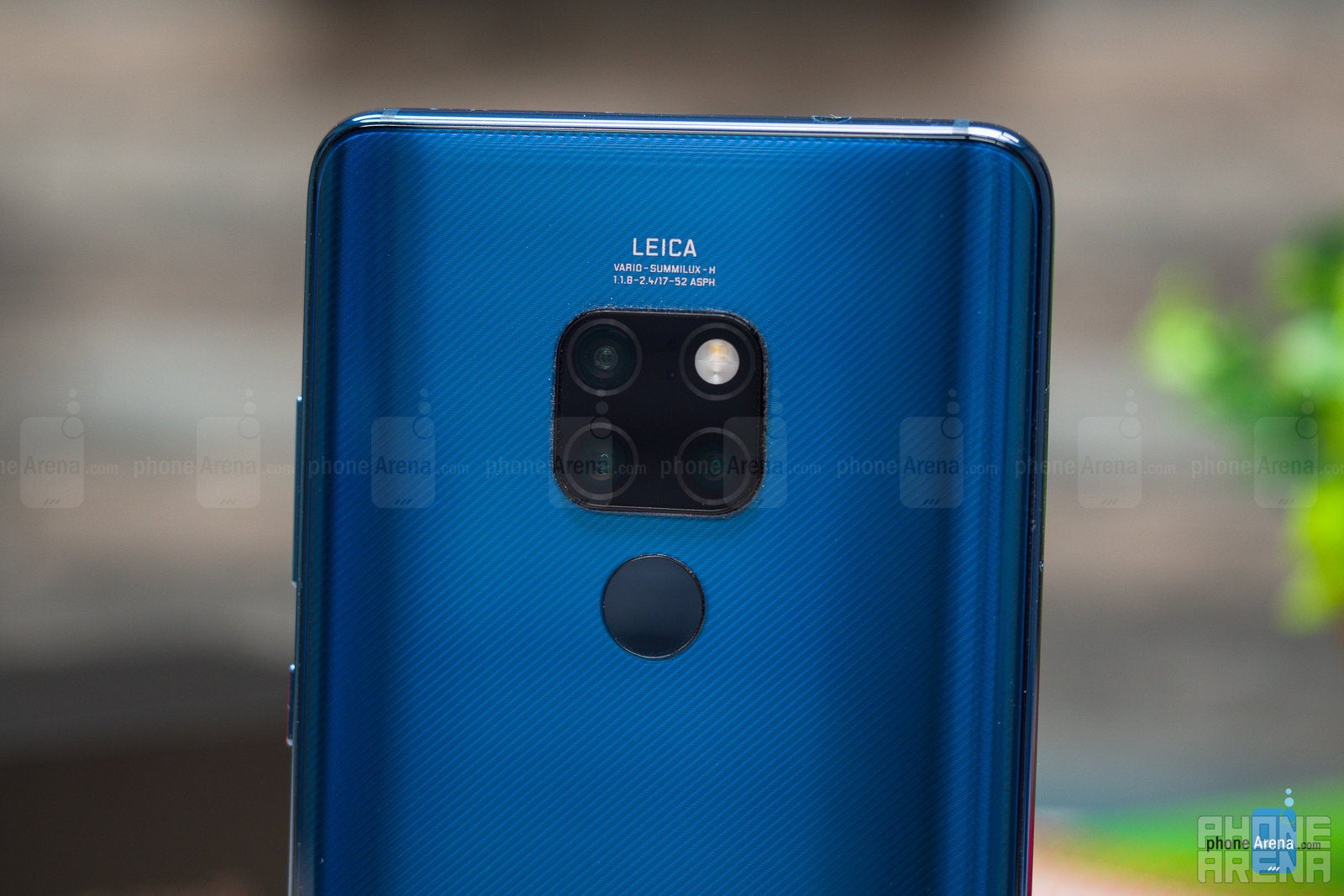
The Mate 20 features not one, not two, but three cameras on its back: we have a main, 12-megapixel f/1.8 shooter, a secondary, 16-megapixel ultra-wide angle lens with a 17mm focal length, and a third, 8-megapixel f/2.4 telephoto camera with 2X zoom for an equivalent of 52mm focal reach. This is not quite the same setup as on the Mate 20 Pro, which has the superior camera, but it is similar in terms of versatility with both an ultra-wide and telephoto cameras on board.
Image Quality
So… how do images actually turn out?
Some people have claimed that the Huawei Mate 20 matches and excels over the top cameraphones out there, but that’s not the case in our testing. It’s a decent camera, but image quality a far-cry from the finest cameras (think iPhone XS/XR and Pixel 3).
Obvious right out the gate is the artificial oversharpening that all photos suffer from, as well as dynamic range that cannot match the clever software magic of the top phone cameras out there. But really, it’s the oversharpening that is the big issue here.
Of course, we are comparing the Mate 20 to the very best out there, since it’s in the same high price range. Had it been priced more affordably, like say a OnePlus 6T, we could have looked at the quality from the point of a cheaper phone, but that’s not really the case here.
Some people have claimed that the Huawei Mate 20 matches and excels over the top cameraphones out there, but that’s not the case in our testing. It’s a decent camera, but image quality a far-cry from the finest cameras (think iPhone XS/XR and Pixel 3).
Obvious right out the gate is the artificial oversharpening that all photos suffer from, as well as dynamic range that cannot match the clever software magic of the top phone cameras out there. But really, it’s the oversharpening that is the big issue here.
Of course, we are comparing the Mate 20 to the very best out there, since it’s in the same high price range. Had it been priced more affordably, like say a OnePlus 6T, we could have looked at the quality from the point of a cheaper phone, but that’s not really the case here.
You can also blur the background with the cameras on the Mate 20, but quite confusingly, there are two modes that do that: a Portrait mode and an Aperture mode. The difference between the two seems to be that Aperture works with everything, from people to inanimate objects, and it automatically starts with 2x zoom camera, while Portrait only works with human beings and defaults to the regular-view camera. Plus, you can adjust the amount of background blur (or bokeh) with Aperture mode, while you cannot do this on Portrait mode images.
While we were not particularly impressed with the main camera of the Mate 20, the Aperture/Portrait mode actually do a great job separating people from the background and the bokeh looks very good. We did not have such a great experience with non-human objects, though. Overall, we recommend giving the more versatile aperture mode a shot, it can yield some very good-looking photographs.
Video quality
The Mate 20 offers video recording at up to 4K resolution and 30fps, plus it also offers the same AI-powered video recording modes as the Pro: AI color and AI background blur. These two modes are really cool, as the first one leaves only your subject in color and turns everything else black and white, while the second mode blurs the background and leaves the subject in sharp focus. Both work surprisingly well. You also have a native cinematic, 21:9 1080p video recording option.
If you look at video recording quality, the footage comes out decent, but not quite flagship-grade. Lacking in the specs list is a 4K60 video recording option, but even in 4K30 you have some very noticeable artifacts towards the edges of the frame when you move the camera, the whole picture seems to wobble in a very unnatural way. Continuous auto focus is also not as fast or as accurate as on the best phones out there.
Sound Quality
On the Mate 20, stereo sound comes from a bottom-firing speaker and from the earpiece. This is different from the sound on the Mate 20 Pro which is more boomy and comes from the earpiece and the USB-C port.
Sound quality on the Mate 20 is not particularly impressive when compared to other flagship phones. It lacks in depth and more so in loudness, even at maximum volume. The lower tonalities also sound a bit thin on the Mate 20. The stereo effect is poor, as the earpiece is barely audible compared to the bottom speaker.
The Mate 20, being a physically big phone, can afford having a 3.5mm headphone jack. It’s located on the top of the phone, so you can easily plug in your good old wired headphones.
Call Quality
When it comes to call quality, we had no issues with the Mate 20. Calls sound crisp, with clarity in the earpiece and a nice amount of volume, so you can hear callers even in loud environments, and the same is true for the other end of the line.
Battery life
Finally, a phone that will last you two days on a single charge.
The Mate 20 comes with a large, 4,000mAh battery that is coupled with a power-efficient LCD screen. How does it all work together?
Quite impressively, actually: the Mate 20 produced the highest score of any 2018 flagship phone when it comes to battery life!
With a score of the whopping 14 hours and 26 minutes, it's head and shoulders above the competition. Take a look at the chart below to see the astounding difference in battery life with the Mate 20:
The only device that comes close to it is the iPhone XR, which scored a respectable 11 hours of battery life.
In real life, you can get two days of usage out of the Mate 20. With most other phones this year, you can get 1 full day, but usually not more.
When it comes to charging times, the Mate 20 ships with a fast charger in the box, and despite the big battery size, it's able to fully recharge in just about an hour and 40 minutes. This is not quite as fast as the ultra-rapid charging on the Mate 20 Pro, but is still plenty fast.
Price and Alternatives
The biggest appeal of the Mate 20 lies in its more bearable price compared to the Pro edition: the phone is sold for around 800 euro, 200 euro less than the flagship Mate 20 Pro. It also offers a significantly bigger display.
So… what are your alternatives?
At this high price, we are still talking about flagships, and the iPhone XR, Samsung Galaxy S9, and Google Pixel 3 are all worthy alternatives. None of them has the long battery life of the Mate, but the iPhone features a superior camera, smoother performance and the promise for updates for years to come, the Galaxy sports a more compact size and a gorgeous Super AMOLED screen, while the Pixel shines with a superior camera and smoother performance.
Conclusion
Summing it all up, the Huawei Mate 20 is a big and powerful Android phone. It has incredible battery life, fast charging and a fast chip inside it. But you get an LCD screen which may be bright, but it doesn't quite have the more impressive colors of an AMOLED one. The phone also lacks a few useful extras like wireless charging. Most notably, it can’t quite match the rest of late 2018 flagships when it comes to camera performance. The unclear update situation is another con.
Is it worth paying the full flagship cost for this one? If you value the incredible battery life, the answer to that is yes, certainly. But if you are looking for the very best screen and camera and a guarantee for updates, there are clearly better options out there.
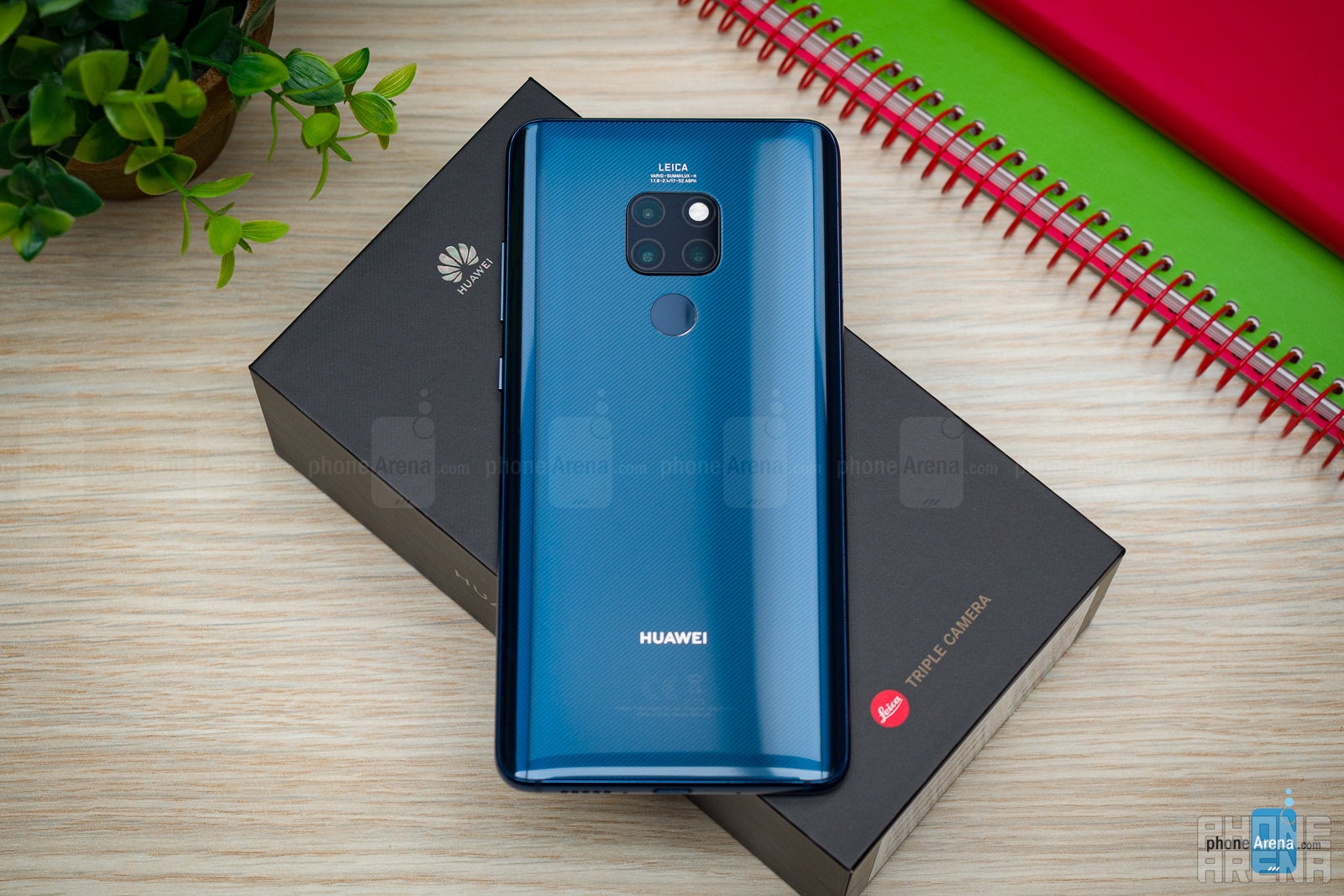
Follow us on Google News

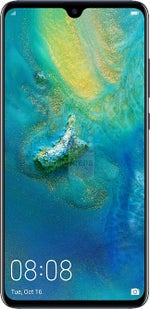
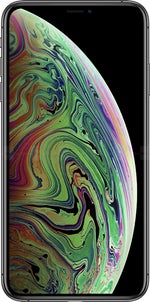
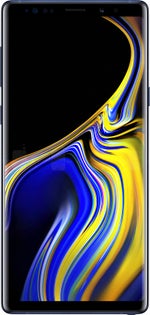
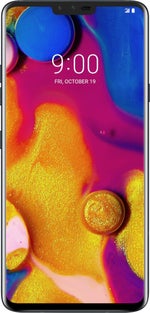

























![A new Android bug is making it impossible to install new apps. Are you affected? [UPDATE]](https://m-cdn.phonearena.com/images/article/176703-wide-two_350/A-new-Android-bug-is-making-it-impossible-to-install-new-apps.-Are-you-affected-UPDATE.webp)

Things that are NOT allowed:
To help keep our community safe and free from spam, we apply temporary limits to newly created accounts: